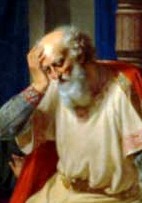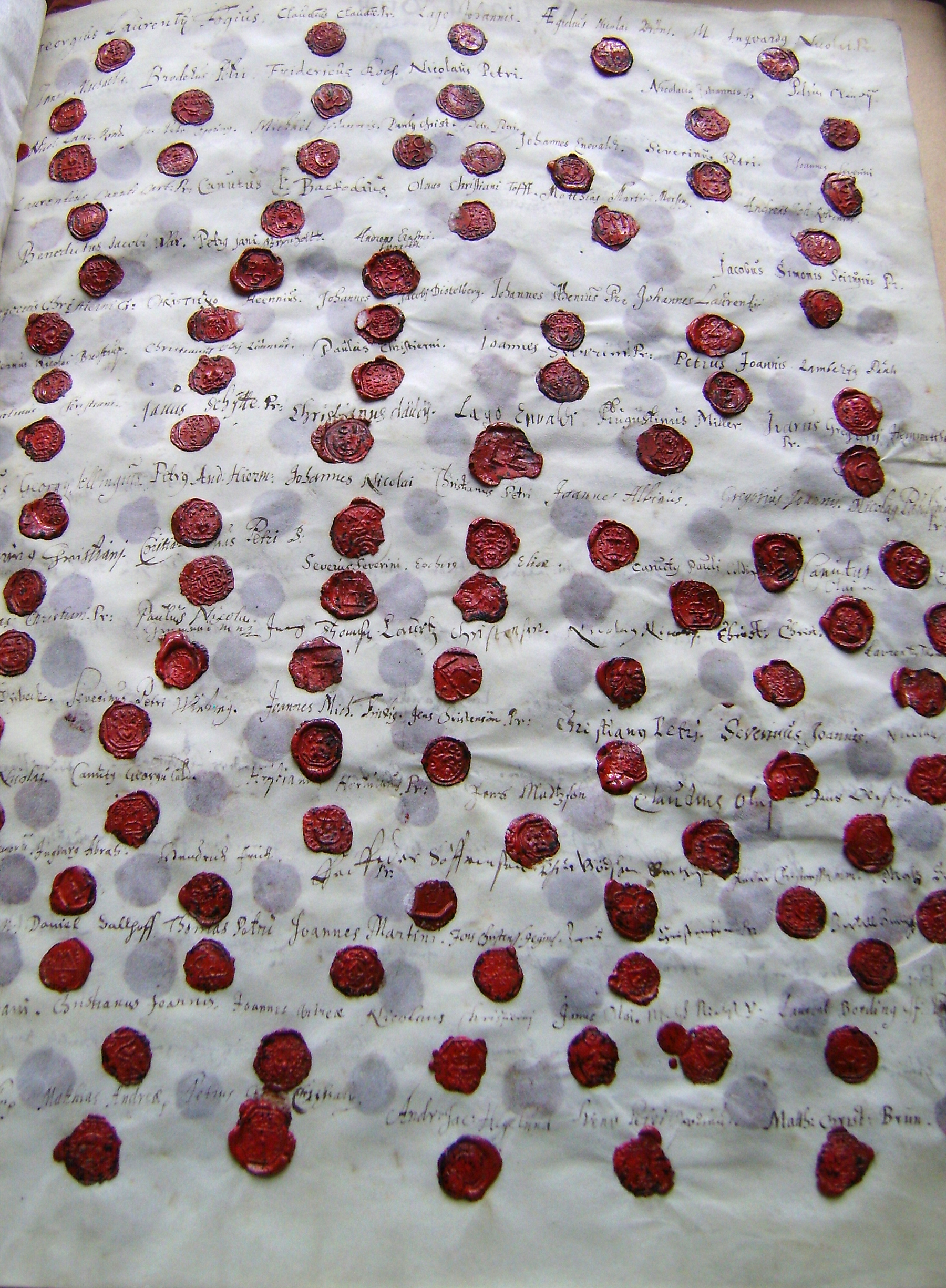|
Frederik III
Frederick III (; 18 March 1609 – 9 February 1670) was King of Denmark and Norway from 1648 until his death in 1670. He also governed under the name Frederick II as diocesan administrator (colloquially referred to as prince-bishop) of the Prince-Bishopric of Verden (1623–29 and again 1634–44), and the Prince-Archbishopric of Bremen (1635–45). The second-eldest son of Christian IV and Anne Catherine of Brandenburg, Frederick was only considered an heir to the throne after the death of his older brother Prince Christian in 1647. He instituted absolute monarchy in Denmark-Norway in 1660, confirmed by law in 1665 as the first in Western historiography. He also ordered the creation of the Throne Chair of Denmark. After failed and costly aggressive wars under Christian IV, most Danes did not want to go to war again. According to Cathal Nolan, when Frederick III became king in 1648, he was excluded from the talks leading to the Peace of Westphalia and had to watch as Br ... [...More Info...] [...Related Items...] OR: [Wikipedia] [Google] [Baidu] |
List Of Danish Monarchs
This is a list of Monarchy of Denmark, Danish monarchs, that is, the kings and queen regnants of Denmark. This includes: * The Kingdom of Denmark (up to 1397) ** Personal union of Denmark and Norway (1380–1397) * The Kalmar Union (1397–1536) ** Union of Denmark, Norway and Sweden (1397–1523) ** Union of Denmark and Norway (1523–1536/1537) * The United Kingdoms of Denmark–Norway (1536/1537–1814) * The Kingdom of Denmark (1814–present) ** Iceland (since the union between Denmark and Norway in 1380; independent kingdom in a personal union with Denmark 1918–1944; a sovereign republic since 1944) ** Greenland (since the union between Denmark and Norway in 1380; effective Danish–Norwegian control began in 1721; integrated into the Danish realm in 1953; internal home rule introduced 1979; Self-governance, self-rule assumed in 2009; Greenland has two out of 179 seats in the Danish parliament Folketinget) ** Faroe Islands (since the union between Denmark and Norway in 138 ... [...More Info...] [...Related Items...] OR: [Wikipedia] [Google] [Baidu] |
Denmark
Denmark is a Nordic countries, Nordic country in Northern Europe. It is the metropole and most populous constituent of the Kingdom of Denmark,, . also known as the Danish Realm, a constitutionally unitary state that includes the Autonomous administrative division, autonomous territories of the Faroe Islands and Greenland in the north Atlantic Ocean.* * * Metropolitan Denmark, also called "continental Denmark" or "Denmark proper", consists of the northern Jutland peninsula and an archipelago of 406 islands. It is the southernmost of the Scandinavian countries, lying southwest of Sweden, south of Norway, and north of Germany, with which it shares a short border. Denmark proper is situated between the North Sea to the west and the Baltic Sea to the east.The island of Bornholm is offset to the east of the rest of the country, in the Baltic Sea. The Kingdom of Denmark, including the Faroe Islands and Greenland, has roughly List of islands of Denmark, 1,400 islands greater than in ... [...More Info...] [...Related Items...] OR: [Wikipedia] [Google] [Baidu] |
King's Law
The King's Law () or ''Lex Regia'' (also called the Danish Royal Law of 1665) was the absolutist constitution of Denmark and Norway from 1665 until 1849 and 1814, respectively. It established complete hereditary and absolute monarchy and formalized the king's absolute power, and is regarded the most sovereign form of all the European expressions of absolutism. Danish professor in legal history of the University of Copenhagen, Jens Chr. V. Johansen, asserts that with Europe's least circumscribed form of absolutism, Denmark "may be considered the most absolute of all the absolute European monarchies". It is the only formal constitution of any absolute monarchy, and has therefore been the subject of considerable historical and academic attention. The King's Law comprises 40 articles and is divided into seven main chapters. Articles 1 to 7 determine the royal absolute power, and the following articles contain rules on the king's authority and guardianship, on the king's access ... [...More Info...] [...Related Items...] OR: [Wikipedia] [Google] [Baidu] |
Christian, Prince Elect Of Denmark
Christian (10 April 16032 June 1647) was Prince-Elect of Denmark from 1610 and Heir Apparent to the Throne of the Kingdom of Norway from 1603. Dying in 1647, he was succeeded by his younger brother, Prince Frederick. Biography Early life Prince Christian was born at Copenhagen Castle to King Christian IV (1577–1648) and Queen Anne Catherine (1575–1612) of Denmark, Norway, etc. Christian was their second son and the oldest one living, as his elder brother Frederik had died in 1599, less than a year old. As such, his father saw him as the preferable heir to the Danish throne. Denmark was an elective monarchy, where elective power was held by the Council of the Realm. However, the King would usually choose an heir and have him hailed as such, thus limiting the Council's freedom of choice. Whilst Norway was formally a hereditary monarchy, making Christian Crown Prince since his birth, it remains likely that the next King of Denmark would not have been another ... [...More Info...] [...Related Items...] OR: [Wikipedia] [Google] [Baidu] |
Archbishopric Of Bremen
The Prince-Archbishopric of Bremen () was an ecclesiastical principality (787–1566/1648) of the Holy Roman Empire and the Catholic Church that after its definitive secularization in 1648 became the hereditary Duchy of Bremen (). The prince-archbishopric, which was under the secular rule of the archbishop, consisted of about a third of the diocesan territory. The city of Bremen was '' de facto'' (since 1186) and ''de jure'' (since 1646) not part of the prince-archbishopric. Most of the prince-archbishopric lay rather in the area to the north of the ''city of Bremen'', between the Weser and Elbe rivers. Even more confusingly, parts of the prince-archbishopric belonged in religious respect to the neighbouring Diocese of Verden, making up 10% of its diocesan territory. History Early diocese of Bremen The foundation of the diocese belongs to the period of the missionary activity of Willehad on the lower Weser. It was erected on 15 July 787 at Worms, on Charlemagne's initiative, h ... [...More Info...] [...Related Items...] OR: [Wikipedia] [Google] [Baidu] |
Prince-Bishopric Of Verden
The Prince-Bishopric of Verden (, ''Hochstift Verden'' or ''Stift Verden'') was an ecclesiastical principality of the Holy Roman Empire that was located in what is today the state of Lower Saxony in Germany. Verden had been a diocese of the Catholic Church since the middle of the 8th century. The state was disestablished in 1648. The territory was managed by secular lords on behalf of the Bishop of Verden. As a Prince-Bishopric of the Empire, the territory of the state was not identical with that of the bishopric, but was located within its boundaries and made up about a quarter of the diocesan area. By the terms of the Peace of Westphalia, the Prince-Bishopric was disestablished and a new entity was established, the Duchies of Bremen and Verden. Location The territory of the Prince-Bishopric of Verden covered the eastern part of the present district of Verden (its border ran between Langwedel and Etelsen), and the southern part of the district of Rotenburg (Wümme) and par ... [...More Info...] [...Related Items...] OR: [Wikipedia] [Google] [Baidu] |
Diocesan Administrator
A diocesan administrator (also known as archdiocesan administrator, archiepiscopal administrator and eparchial administrator for the case, respectively, of an archdiocese, archeparchy, and eparchy) is a provisional ordinary of a Catholic particular church. Diocesan or archdiocesan administrators in canon law The college of consultors elects an administrator within eight days after the see is known to be vacant. The college must elect as administrator a priest, bishop, or archbishop at least 35 years old. If the college of consultors fails to elect a priest of the required minimum age within the time allotted, the choice of an administrator passes to the metropolitan archbishop or, if the metropolitan see is vacant, to the senior by appointment of the suffragan bishops of the ecclesiastical province. If a diocese has a coadjutor bishop, the coadjutor succeeds immediately to the episcopal see upon the previous bishop's death or resignation, and there is no vacancy of the se ... [...More Info...] [...Related Items...] OR: [Wikipedia] [Google] [Baidu] |
Norway
Norway, officially the Kingdom of Norway, is a Nordic countries, Nordic country located on the Scandinavian Peninsula in Northern Europe. The remote Arctic island of Jan Mayen and the archipelago of Svalbard also form part of the Kingdom of Norway. Bouvet Island, located in the Subantarctic, is a Dependencies of Norway, dependency, and not a part of the Kingdom; Norway also Territorial claims in Antarctica, claims the Antarctic territories of Peter I Island and Queen Maud Land. Norway has a population of 5.6 million. Its capital and largest city is Oslo. The country has a total area of . The country shares a long eastern border with Sweden, and is bordered by Finland and Russia to the northeast. Norway has an extensive coastline facing the Skagerrak strait, the North Atlantic Ocean, and the Barents Sea. The unified kingdom of Norway was established in 872 as a merger of Petty kingdoms of Norway, petty kingdoms and has existed continuously for years. From 1537 to 1814, Norway ... [...More Info...] [...Related Items...] OR: [Wikipedia] [Google] [Baidu] |
Den Store Danske Encyklopædi
''Den Store Danske Encyklopædi'' () is the most comprehensive contemporary Danish language encyclopedia. The 20 volumes of the encyclopedia were published successively between 1994 and 2001; a one-volume supplement was published in 2002 and two index volumes in 2003. The work comprises 115,000 articles, ranging in size from single-line cross references to the 130-page entry on Denmark. The articles were written by a staff of about 4,000 academic experts led by editor-in-chief Jørn Lund. Articles longer than a few dozen lines are signed by their authors. Many articles are illustrated. The encyclopedia was published by ''Danmarks Nationalleksikon A/S'' (Denmark's National Encyclopedia), a subsidiary of Denmark's publishing house Gyldendal that was set up for the purpose. The project was inspired by the almost contemporary Swedish ''Nationalencyklopedin''; it received financial support from the Augustinus Foundation and was backed by a governmental inflation guarantee on pre-pa ... [...More Info...] [...Related Items...] OR: [Wikipedia] [Google] [Baidu] |
Lutheran
Lutheranism is a major branch of Protestantism that emerged under the work of Martin Luther, the 16th-century German friar and Protestant Reformers, reformer whose efforts to reform the theology and practices of the Catholic Church launched the Reformation in 1517. The Lutheran Churches adhere to the Bible and the Ecumenical Creeds, with Lutheran doctrine being explicated in the Book of Concord. Lutherans hold themselves to be in continuity with the apostolic church and affirm the writings of the Church Fathers and the first four ecumenical councils. The schism between Roman Catholicism and Lutheranism, which was formalized in the Diet of Worms, Edict of Worms of 1521, centered around two points: the proper source of s:Augsburg Confession#Article XXVIII: Of Ecclesiastical Power., authority in the church, often called the formal principle of the Reformation, and the doctrine of s:Augsburg Confession#Article IV: Of Justification., justification, the material principle of Luther ... [...More Info...] [...Related Items...] OR: [Wikipedia] [Google] [Baidu] |




